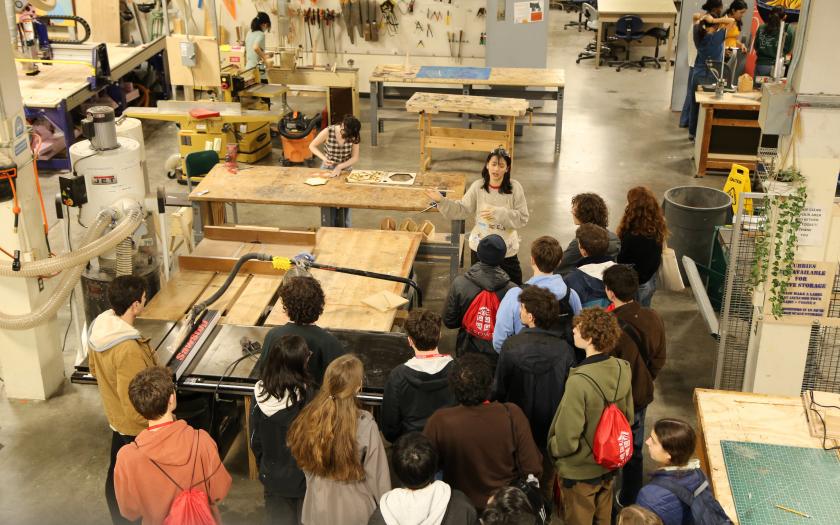BDW 101, Part II: I-BEAM’s Guide to the Brown Design Workshop

A Brown Design Workshop Tour.
“The Grand Challenge:” Sustainability in the BDW
What do 3D-printed keychains, wooden cutting boards, a paper-mache model of the solar eclipse, and a Formula One-style car all have in common? They were made in the Brown Design Workshop (BDW). While that diversity of craft is part of what makes the BDW so special, it also means that thousands of materials are cycling through the space every year — and thousands of scraps are left behind.
“There's a tension between being creative and making things and the inevitable waste,” said BDW Director Louise Manfredi. “We don’t have control of all the materials that come in — people bring things in.” In addition, Louise says that the majority of people surveyed by the BDW last fall didn’t know about the environmental impacts of the materials they used.
Louise says making the BDW more sustainable is “the grand challenge and it’s one that I’m really excited to be a part of.” And she’s started to make good progress on that mission.
That starts with making people “aware of the resources you are using,” said Jules Silva, a manager in the BDW. “A greater emphasis on material reuse and recycling has come about through projects like displays of carbon footprint information,” said Manager Serena Vu.
Each time someone uses a brand new material, they are responsible for the negative environmental impact of its use, Louise said. However, if you are giving a material a second life, your reimagining is environmentally neutral”.
That’s why the BDW team developed a material circulation station to collect scraps of wood, metals, plastics, and more for people to collect and reuse. “When you have leftover materials and put them in the circulation station, the next person that takes them doesn’t have an environmental impact anymore because it was already absorbed by the first use,” explained Louise.
“We try to reuse parts when we can — for costs and for just not having to throw things away,” said Brown Formula Racing lead cooling system engineer Chandler Zhu. Louise also noted that having the ability to reuse materials lowers barriers to entry for potential BDW members because it makes creating cheaper — members are less likely to have to bring their own materials. “We’re big on having a scrap area that’s accessible and free to use,” said Jules.
One of the BDW’s most popular stations — its 3D printing area — has proven one of the greatest sustainability challenges. Even PLA filament, which is often touted as a more sustainable 3D printing filament than other options, isn’t environmentally benign — it can only biodegrade in certain, specific conditions. And, even if a user only intends to use a small amount of filament, the supports required to hold up a print create a lot of waste.
Louise says the BDW is working out how to recycle its excess PLA. In partnership with Leo Kobayashi, they have built a filament re-extrusion process to reduce landfill waste and lower the economic cost of PLA filament. Jules said BDW staff has begun to color-code printing supports and melt them down into laser cuttable sheets. Other areas, like woodworking, have also been focus points for the BDW.
The BDW team is working out how to make their introductory woodworking workshops more sustainable. Typically, the workshops involve creating a small wooden toolbox — but oftentimes the final projects are left behind, Louise said. Now, they are reworking the introductory class to have a box that could be reused or taken apart for the material circulation station. They are also hoping to donate projects to local schools or youth organizations — projects that could then be painted or decorated for art classes or other projects.
As sustainability initiatives are underway, the BDW is continuously taking steps to measure their successes — and the areas in which they still need to improve. Louise says they are measuring the amount of waste they produce, surveying members about sustainability issues, and regularly updating their material circulation station. Jules said the BDW has even started an Undergraduate Teaching and Research Award (UTRA) to look into life cycle assessments for the BDW, analyzing the environmental impacts of creation in the space. Manfredi was recently awarded a Hazeltine Innovate grant to capture data from BDW operations with a view to creating a digital sustainability dashboard. Louise added, “We are all in the fight against climate change together. Visibility on how we are reducing our environmental impact as a community is critical and becoming integral to the mission of the BDW as an informal learning space”.
“We have a lot of sustainability projects that we’re working towards right now,” said Jules. As far as Jules and the BDW team are concerned, there will be “lots of little projects and larger projects” to work on until the space is as environmentally friendly as possible.
To learn more about the BDW, stay tuned for another article from I-BEAM focusing on the space’s commitment to inclusivity, or read our introduction to the BDW.
LinkedIn accounts
Abigael Bousquet, Women Build at Brown
Instagram accounts
Women Build at Brown: @womenbuildatbrown
Brown Formula Racing: @brownformularacing
Brown Design Workshop: @brownbdw
Websites